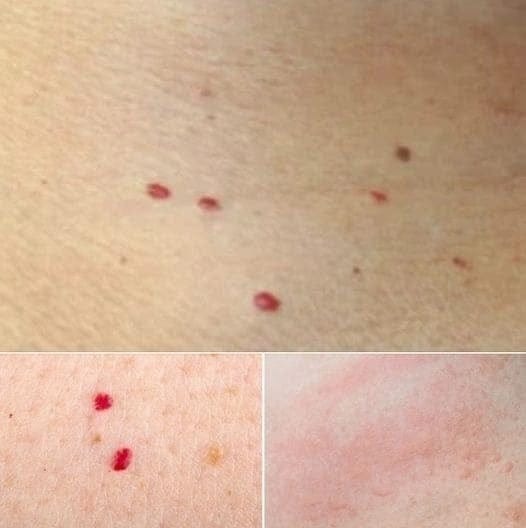ADVERTISEMENT
### 2. **Common Causes of Red Dots on the Skin**
#### 1.1 **Petechiae**
Petechiae are small, flat, red or purple dots that often appear in clusters. These dots are caused by tiny blood vessels under the skin breaking, leading to bleeding beneath the surface. Petechiae are usually no bigger than the head of a pin and are often found on the arms, legs, and torso.
**Causes of Petechiae:**
– **Infections:** Certain viral or bacterial infections, including strep throat, meningitis, and sepsis, can cause petechiae to appear.
– **Trauma or Injury:** Physical trauma, such as heavy coughing, vomiting, or excessive straining, can lead to the formation of petechiae. For example, people who engage in intense physical activity or lifting heavy objects might experience petechiae due to pressure.
– **Blood Disorders:** Conditions such as thrombocytopenia (low platelet count) or leukemia can lead to the formation of petechiae due to the body’s inability to clot blood properly.
– **Medications:** Certain medications, especially blood thinners or anticoagulants, can increase the risk of petechiae. Aspirin, for instance, is known to cause bleeding under the skin.
**What to do:** If you notice petechiae, particularly if they are widespread or accompanied by other concerning symptoms like fever, fatigue, or bruising, you should seek medical attention immediately.
#### 1.2 **Hives (Urticaria)**
Hives, or urticaria, are raised, red or pinkish bumps or welts that may appear on the skin. They are often itchy and can range in size from small dots to large patches. Hives are typically caused by an allergic reaction, although they can also result from stress, infections, or other triggers.
**Causes of Hives:**
– **Allergies:** Allergic reactions to foods, medications, insect bites, or environmental factors such as pollen or dust mites can cause hives.
– **Infections:** Viral infections like the common cold, flu, or even the stomach flu can trigger hives.
– **Stress:** Emotional stress or anxiety can lead to the development of hives in some people.
**What to do:** Most cases of hives resolve on their own within a few hours or days. However, if hives persist or cause significant discomfort, antihistamines can be used to reduce itching and inflammation. In severe cases, a doctor may prescribe corticosteroids or other medications.
#### 1.3 **Heat Rash (Miliaria)**
Heat rash, also known as miliaria, occurs when sweat gets trapped in blocked sweat ducts, causing tiny red or pink bumps on the skin. It is more common in hot, humid conditions and typically appears in areas where sweat accumulates, such as the chest, back, neck, and groin.
**Causes of Heat Rash:**
– **Hot and Humid Weather:** Heat rash is most common in hot, sweaty environments, especially during the summer months or when engaging in physical activities.
– **Excessive Sweating:** Overheating due to exercise, fever, or tight clothing can trigger heat rash.
**What to do:** Heat rash usually clears up on its own when the body cools down and the sweat ducts are no longer blocked. To speed up recovery, try cooling down the skin by staying in a cool environment, wearing loose clothing, and avoiding excessive sweating. Over-the-counter creams and lotions, such as calamine lotion, may help soothe the irritation.
#### 1.4 **Cherry Angiomas**
Cherry angiomas, also known as senile angiomas, are small, bright red or purple spots that typically appear as a result of abnormal blood vessel growth under the skin. They are benign (non-cancerous) and are most common in individuals over the age of 30. Cherry angiomas can range in size from a tiny dot to a larger, raised bump.
For Complete Cooking STEPS Please Head On Over To Next Page Or Open button (>) and don’t forget to SHARE with your Facebook friends
